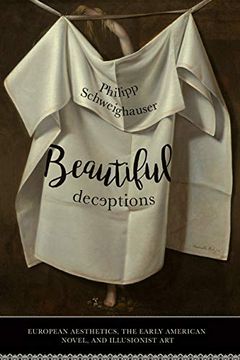Compartir
Beautiful Deceptions: European Aesthetics, the Early American Novel, and Illusionist art (en Inglés)
Philipp Schweighauser (Autor)
·
University Of Virginia Press
· Tapa Dura
Beautiful Deceptions: European Aesthetics, the Early American Novel, and Illusionist art (en Inglés) - Philipp Schweighauser
$ 47.37
$ 64.29
Ahorras: $ 16.92
Elige la lista en la que quieres agregar tu producto o crea una nueva lista
✓ Producto agregado correctamente a la lista de deseos.
Ir a Mis ListasSe enviará desde nuestra bodega entre el
Jueves 30 de Mayo y el
Viernes 31 de Mayo.
Lo recibirás en cualquier lugar de Estados Unidos entre 1 y 3 días hábiles luego del envío.
Reseña del libro "Beautiful Deceptions: European Aesthetics, the Early American Novel, and Illusionist art (en Inglés)"
The art of the early republic abounds in representations of deception: the villains of Gothic novels deceive their victims with visual and acoustic tricks; the ordinary citizens of picaresque novels are hoodwinked by quacks and illiterate but shrewd adventurers; and innocent sentimental heroines fall for their seducers' eloquently voiced half-truths and lies. Yet, as Philipp Schweighauser points out in Beautiful Deceptions, deception happens not only within these novels but also through them. The fictions of Charles Brockden Brown, Hugh Henry Brackenridge, Susanna Rowson, Hannah Webster Foster, Tabitha Gilman Tenney, and Royall Tyler invent worlds that do not exist. Similarly, Charles Willson Peale's and Raphaelle Peale's trompe l'oeil paintings trick spectators into mistaking them for the real thing, and Patience Wright's wax sculptures deceive (and disturb) viewers. Beautiful Deceptions examines how these and other artists of the era at times acknowledge art's dues to other social realms-religion, morality, politics-but at other times insist on artists' right to deceive their audiences, thus gesturing toward a more modern, autonomous notion of art that was only beginning to emerge in the eighteenth century. Building on Alexander Gottlieb Baumgarten's definition of aesthetics as ""the science of sensuous cognition"" and the writings of early European aestheticians including Kant, Schiller, Hume, and Burke, Schweighauser supplements the dominant political readings of deception in early American studies with an aesthetic perspective. Schweighauser argues that deception in and through early American art constitutes a comment on eighteenth-century debates concerning the nature and function of art as much as it responds to shifts in social and political organization.

